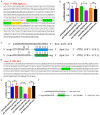miR-424 suppresses proliferation and promotes apoptosis of human ovarian granulosa cells by targeting Apelin and APJ expression
- PMID: 32774725
- PMCID: PMC7407740
miR-424 suppresses proliferation and promotes apoptosis of human ovarian granulosa cells by targeting Apelin and APJ expression
Erratum in
-
Erratum: miR-424 suppresses proliferation and promotes apoptosis of human ovarian granulosa cells by targeting Apelin and APJ expression.Am J Transl Res. 2021 Apr 15;13(4):3917-3918. eCollection 2021. Am J Transl Res. 2021. PMID: 34017582 Free PMC article.
Abstract
Objective: Polycystic ovary syndrome (PCOS) is associated with alteration of Apelin signaling in ovarian granulosa cells (GCs). However, the molecular mechanisms regulating Apelin expression remain poorly understood. This study aims to investigate the role of miR-424 in modulating Apelin expression and GC functions.
Methods: miRNA expression in GCs was altered by transfection with specific miR-424 mimics and inhibitors. Apelin level was determined by ELISA. miR-424 and mRNA expression were analyzed by quantitative RT-PCR. Protein abundance was measured by western blotting. Genomic sequence targeted by miR-424 was validated by dual-luciferase reporter assay. Apelin gene was overexpressed by transfection of LV-003 vector carrying its cDNA. GC proliferation was analyzed by MTS method, and its cell cycle progression and apoptosis were measured by flow cytometry.
Results: Apelin concentration was increased in serum and follicular fluid from PCOS patients, accompanied by upregulated APJ (Apelin receptor) expression and suppressed miR-424 expression in GCs. miR-424 mimics suppressed Apelin and APJ expression in KGN cells by targeting 3' UTR of Apelin and APJ, whereas miR-424 inhibitors had the opposite effects. miR-424 inhibited KGN cell proliferation and cell cycle progression by down-regulating Cyclin-D/E expression. Moreover, miR-424 promoted KGN cell apoptosis by increasing truncated Caspase-3 level. The regulation of KGN cell proliferation and apoptosis by miR-424 was mediated by directly suppressing Apelin gene expression, instead of inhibiting Apelin peptide activity.
Conclusion: miR-424 suppresses proliferation and promotes apoptosis of human ovarian granulosa cells by directly targeting and inhibiting Apelin and APJ expression.
Keywords: APJ; Apelin; apoptosis; granulosa cell; miR-424; proliferation.
AJTR Copyright © 2020.
Conflict of interest statement
None.
Figures






References
-
- Ginsburg J, Havard CW. Polycystic ovary syndrome. Lancet. 2011;51:415–422.
-
- Li R, Zhang Q, Yang D, Li S, Lu S, Wu X, Wei Z, Song X, Wang X, Fu S. Prevalence of polycystic ovary syndrome in women in China: a large community-based study. Human Reproduction. 2013;28:2562–2569. - PubMed
-
- Franks S, Mccarthy MI, Hardy K. Development of polycystic ovary syndrome: involvement of genetic and environmental factors. Int J Androl. 2006;29:278–285. discussion 286-290. - PubMed
-
- Burks HR, Wild RA. Polycystic Ovary Syndrome. Springer; 2014. Diagnostic criteria and epidemiology of PCOS; pp. 3–10.
LinkOut - more resources
Full Text Sources
Research Materials
Miscellaneous
